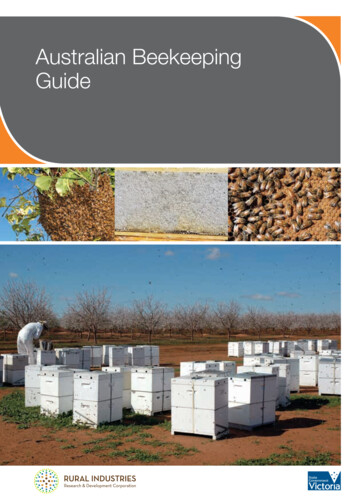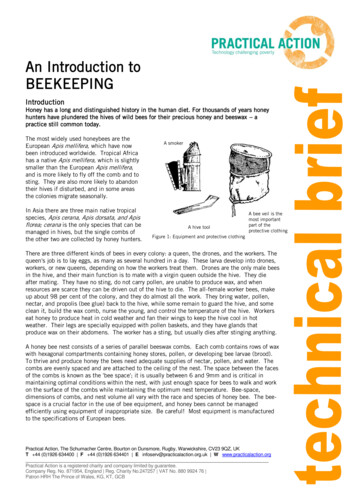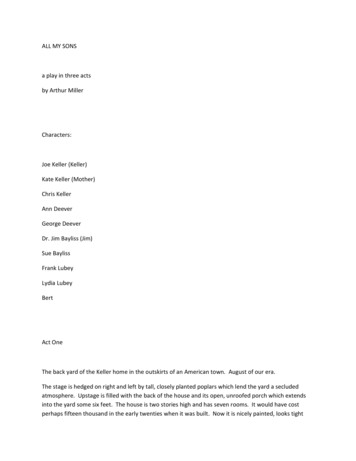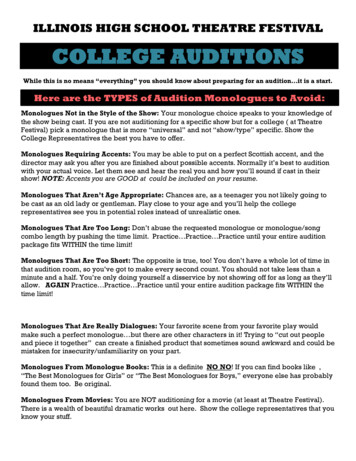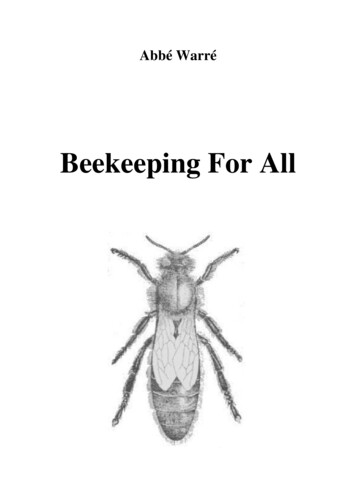
Transcription
Abbé WarréBeekeeping For All1
Translated from the original French version of L'Apiculture Pour Tous (12th edition)1 by Patricia andDavid Heaf. Eighth electronic English edition with a minor correction and improved images, October2015. Patricia Heaf and David Heaf, July 2007Patricia and David Heaf reserve all rights to their translation subject to the terms of the CreativeCommons license shown on page 155.For permissions please contact: David Heaf, Hafan, Cae Llwyd, Llanystumdwy, Gwynedd, LL52 0SG,UK. Email: david (at) dheaf.plus.com.Note by Guillaume Fontaine in the electronic version of the French 12th edition2: "Abbé Warré died in1951. According to intellectual property law3, his heirs should give permission for use of his writings.Having not been able to contact his heirs, I am permitted to distribute this document to anyone foraccess by anyone. And to let people know about this kind of beekeeping."1.Reproduction of the 1948 edition; Legal Deposit: 4th term, 1948.Distributed at http://www.apiculture-warre.fr/.3.Art. L. 123-1: "The author enjoys during his life the exclusive right to use his work in any form whatever andto obtain financial gain from it. At the death of the author, this right remains for the enjoyment of hisbeneficiaries during the current civil year and the following seventy years."2.AcknowledgementThe translators thank Mandy Fritzsche, translator of the German edition, for making available herdigitally enhanced images scanned from the original printed edition of L'Apiculture Pour Tous.2
Ainsi le voyageur qui, dans son court passage,Se repose un moment l’abri du vallon,Sur l’arbre hospitalier, dont il goûta l’ombrage,Avant que de partir, aime graver son nom.So the traveller who, in his short journey,Rests a while in the shelter of the valeOn the hospitable tree, whose shade he enjoys,Before leaving, likes to carve his name.LamartineBefore leaving, I would like, dear bees, to carve my name on these leaves, blessed shrub thathas taken all its sap from around your dwelling place.In its shade, I have rested from my weariness, have healed my wounds. Its horizon satisfies mydesires for there I can see the heavens.Its solitude is more gentle than deep. Your friends are visiting it. You enliven it with yoursinging.And because you do not die, dear bees, you will sing again and for ever, in the surroundingfoliage, where my spirit will rest.Thank you.E. Warré3
BEEKEEPING FOR ALLThe purpose of beekeepingApiculture or beekeeping is the art of managing bees with the intention of getting the maximumreturn from this work with the minimum of expenditure.Bees produce swarms, queens, wax and honey.The production of swarms and queens should be left to specialists.The production of wax has some value, but this value is diminished by the cost of rendering.The production of honey is the main purpose of beekeeping, one that the beekeeper pursuesbefore everything else, because this product is valuable and because it can be weighed and priced.Honey is an excellent food, a good remedy, the best of all sweeteners. We shall go into this inmore detail. And we can sell honey in many forms just as we can consume it in many forms: as it is, inconfectionery, in cakes and biscuits, in healthy and pleasant drinks – mead, apple-less cider, grape-lesswines.It is also worth noting that beekeeping is a fascinating activity and consequently rests both mindand body.Furthermore, beekeeping is a moral activity, as far as it keeps one away from cafés and low placesand puts before the beekeeper an example of work, order and devotion to the common cause.Moreover, beekeeping is a pre-eminently healthy and beneficial activity, because it is most oftendone in the fresh air, in fine, sunny weather. For sunshine is the enemy of illness just as it is the masterof vitality and vigour. Dr Paul Carton wrote: 'What is needed is to educate a generation in dislikingalcohol, in despising meat, in distrusting sugar, in the joy and the great benefit of movement'.For the human being is a composite being. The body needs exercise without which it atrophies.The mind needs exercising too, otherwise it deteriorates. Intellectuals deteriorate physically. Manualworkers, behind their machines, suffer intellectual deterioration.Working on the land is best suited to the needs of human beings. There, both mind and body playtheir part.But society needs its thinkers, its office workers and its machine operatives. Clearly these peoplecannot run farms at the same time. But in their leisure time (they must have some of it) they can begardeners and beekeepers and at the same time satisfy their human needs.This work is better than all modern sports with their excesses, their promiscuity, their nudity.Thus if the French were to return to the land they would be more robust, more intelligent. And asthe wise Engerand said, France would again become the land of balance where there would be neitherthe agitations, nor the collective follies that are so harmful to people; it would become again a land ofrestraint and clarity, of reason and wisdom, a country where it is good to live.And let us not forget the advice of Edmond About: 'The only eternal, everlasting andinexhaustible capital is the earth'.Finally, one more important thing: the bees fertilise the flowers of the fruit trees. Apiculture thuscontributes greatly to filling our fruit baskets. This reason alone should suffice to urge all those whohave the smallest corner of orchard to take up beekeeping.According to Darwin, self-fertilisation of flowers is not the general rule. Cross-fertilisation, whichtakes place most commonly, is necessitated becaus of the separation of sexes in flowers or even on1
different plants; or because of the non-coincidence of maturity of pollen and stigma or by the differentmorphological arrangements which prevent self-fertilisation in a flower. It happens very often that ifan outside agent does not intervene, our plants do not fruit or they yield far less; many experimentsdemonstrate this.As Hommell put it so well: the bee, attracted by the nectar secreted at the base of the petals,penetrates to the bottom of the floral envelope to drink the juices produced by the nectaries, and coversitself with the fertilising dust that the stamens let fall. Having exhausted the first flower, a secondpresents a new crop to the tireless worker; the pollen it is carrying falls on the stigma and thefertilisation which, without it, would be left at the mercy of the winds, takes place in a way that isguaranteed. Thus the bee, following its course without relaxation, visits thousands of corollae, anddeserves the poetic name that Michelet gave it: the winged priest at the marriage of the flowers.Hommell even attempted to put a figure on the benefit that resulted from the presence of bees. Acolony, he said, which has only 10,000 foragers should be considered as reaching barely average, anda large stock housed in a big hive often has 80,000. Suppose 10,000 foragers go out four times a day,then in 100 days this will make four million sorties. And if each bee before returning home enters onlytwenty-five flowers, the bees of this hive will have visited 100 million flowers in the course of oneyear. It is no exaggeration to suppose that on ten of these flowers, at least one is fertilised by the actionof the foragers and that the resulting gain would be only 1 centime for every 1,000 fertilisations. Yet inspite of these minimal estimates, it is evident that there is a benefit of 100 francs a year produced bythe presence of just one hive. This mathematical conclusion is irrefutable.Certain fruit producers, above all viticulturists, set themselves up in opposition to bees becausebees come and drink the sweet juices of fruit and grapes. But if we investigate the bee closely we soonnotice that they ignore the intact fruits and only empty those with pellicles that are already perforatedby birds or by the strong mandibles of wasps. The bee only gathers juice which, without it, would dryup and be wasted. It is totally impossible for bees to commit the theft they are accused of, because themasticatory parts of its mouth are not strong enough to enable it to perforate the fruit pellicle thatprotects the pulp.The benefits of beekeepingI pity those who keep bees only to earn money. They deprive themselves of a very sweetenjoyment.However, money is necessary to live. Money is useful to those who like to spread happinessaround themselves.Consequently it is justifiable to imagine that this could result from beekeeping.But reading certain books and certain periodicals may lead to error on this point.The liesTo encourage a return to the land or to deceive those who return there, beekeeper committees orsome anti-French people published some staggering things in the newspapers. Perhaps there were alsoselfish beekeepers among them professing poor results so as not to create competition.Thus a prominent beekeeper claims that a harvest of only 10 kg is a rare maximum. At the otherextreme, a professor asserts that honey harvests should average 100 kg per hive if rational beekeepingmethods are adopted.2
A doctor declares that in America a single hive can yield an average annual harvest of 190 kg ofhoney, and that it is up to us to make it as much. Doubtless this would be by giving each hive 200 kgof sugar. But would not the fraud be exposed?The truthNo type of hive, no method of beekeeping turns stones into honey. Neither do they make thebeekeeper any wiser, or increase queen fertility or improve the ambient temperature. As a result theyield of a hive varies from one region to another, from one hive to another and from one year toanother, just as does the nectar wealth of the region, queen fertility, temperature and the skill of thebeekeeper.When I lived in the Somme, I had an average annual harvest of 25 kg per hive. In a region with ahigh nectar yield one can harvest more. Here at Saint-Symphorien, in a region which is poor fornectar, I average only 15 kg. To be exact: in 1940 I had hives that cost me 300 francs each. Each gaveme a harvest of 15 kg. Now the price of honey was fixed at 18 francs wholesale, 22 francs retail.Furthermore, each hive required one and a half hours of my time in the course of the year.One can see with this how work and capital are rewarded in beekeeping, even in a region poorerin nectar.Beekeeping is a good schoolCoppée said that good fortune is giving it to others. Good fortune accrues to the souls of the elite.Now good fortune is not always possible, but you can find a considerable fortune in nature.With flowers it is the beauty that endlessly rejuvenates itself. With dogs it is the boundlessfaithfulness, even in misfortune – unfailing recognition. The bee is a mistress and a delightful teacher.She provides an example of a wise and reasoned lifestyle, which gives solace from life's annoyances.The bee contents herself with the nourishment provided in the surroundings of the hive, withoutadding anything to it and without taking anything away from it. No ready-made meals; no importedearly fruit or vegetables.The bee, however well provided she is, does not consume more than is absolutely necessary. Nogluttony.The bee makes use of her terrible sting and dies in doing so in order to defend her family and herprovisions. Otherwise, even when she is foraging, she gives way peacefully to people and to animals.without recrimination, without a fight. She is a pacifist, but not weak.Each bee has its task according to its age and abilities. It fulfils its task without desire, rebellion oranger. For the bee there is no humiliating work.The queen lays tirelessly, thus assuring the perpetuation of the stock. The workers lovingly sharetheir activity between the tender larvae, the hopes of the colony's future, and the fragrant fields wherethe honey is harvested from dawn to dusk. No place in a buzzing colony for the useless. Noparliaments; for this quiet populace has neither a taste for new laws nor the leisure for futilediscussion.We call the laying bee the queen. This is incorrect. There is neither king nor queen nor dictator inthe hive. Nobody is in charge, yet all work in the common interest. No egoism.The bee observes the law that is as healthy as it is imperative, a law often overlooked by humans:'you earn your bread by the sweat of your brow'. And I observe that the sweat of the bee, just in3
cleansing her body, is useful to her in another way. Her sweat, in changing into scales of wax,provides the bee with the materials that she uses to make her wonderful cells, a clean storehouse forher provisions, a soft cradle for her young. It is so true that the observance of natural laws is alwaysrewarded.Bees work day and night without respite. They only take a rest when there is no work to do. Noteven a rest at the weekends. In the home of the bees there are neither pensioners nor retirees.And here is the song of the bees that Théodore Botrel sang:I said one day to the beeRest a little now,Your striving to be likeThis pretty blue butterflyOn the rose or the pansy,See, it swoons in day-dreamingYes. but, me, I'm in a hurry,Said the bee to me, in passing.Showing her the dragonfly,I said to her, another dayCome, from dawn to dusk,Dance like her, when it's your turnDon't you admire it, subtle,Waltzing over there on the lake?Yes. but me, I am usefulSaid the bee to me, leaving.Yesterday, before the doorOf its little temple of goldI caught sight of it, half dead,Heavy with its pollen againRest yourself, poor creatureI said to her while helping herYes. when my task is done,The bee said to me as she died.4
Henry Bordeaux said "What I admire most in the bee colony is the bee's total disregard for itself;she gives her self wholly to a job she will not enjoy – joy in the effort and giving of herself".And for me bees are what birds were for André Theuret:"When I hear the bees buzzing in the foliage, I dream with the slight feeling that they are singingin the same way as those I used to hear in my childhood, in my parents' garden".One good thing about bees is they always seem to be the same. Some years pass; we age, we seeour friends disappear, revolutionary changes take their effect, illusions fall one after the other, and yet,amongst the flowers, the bees that we have known from childhood modulate the same musical phrases,with the same freshness of voice. Time seems not to have taken its toll on them, and, as they hidethemselves to die, as we never help them in their agony, we can imagine that we always have beforeour eyes those that enchanted our early childhood, those too who, during our long existence, haveprovided for us the happiest hours and the rarest of friends.As a lover of nature once said: happy he who, resting in the grass in the evening close to anapiary, in the company of his dog, heard the song of the bees blending itself with the chirping of thecrickets, with the sound of the wind in the trees, the twinkling of the stars and the slow march of theclouds!The beeThe place of bees in natureAnimals, which are distinguished from plants through being able to move, are divided into twomain categories: vertebrates and invertebrates.The vertebrates, characterised by their vertebral column, comprising fish, batrachians, reptiles,birds and mammals, are of no interest here.The invertebrates, those not having a vertebral column, have several branches: protozoa(infusoria), sponges, coelenterates (medusae, corals), echinoderms (sea urchins), worms (leeches,lumbricus), bryozoa, rotifers, molluscs (oysters, slugs, octopuses), arthropods and finally the chordata,which with their dorsal chord, form the transition between the invertebrates and the vertebrates.It is the arthropods that interest us here.The arthropods (from the Greek 'arthron', articulation, and 'ports, podos', foot) are also calledArticulata. Their bodies show three distinct regions, head, thorax and abdomen. These are equippedwith appendages: on the head the antennae and organs of mastication; on the thorax, the limbs.Arthropods are divided into several classes: crustacea (lobsters), arachnids (spiders), myriapods(centipedes), insects or hexapods.The insects (from Latin 'in', in, 'secare', cut), or hexapods (from Greek: 'hex', six, and 'pous, podos'foot) are characterised by always having six limbs. Insects breathe air.5
An insectA: Bumble-bee, B: Bumble-bee nest, C: OsmiaTop to bottom: A mother – a worker – a male (life size)6
Their heads have two compound eyes. The thorax is divided into three parts, the prothorax whichcarries a pair of legs, the mesothorax which carries a pair of legs and a pair of wings, the metathoraxwhich carries a pair of legs and sometimes a pair of wings. Insects always have the sexes separate. Thelarva after hatching from the egg undergoes a series of metamorphoses until it comes to resemble itsparents. Because of their intelligence and organisation, insects are superior to other invertebrates. The600,000 known species of insect are divided into eight orders: orthoptera (grasshoppers), neuroptera(ant-lions), odonata (dragonflies), hemiptera (bugs), diptera (fleas), lepidoptera (butterflies),coleoptera (cockchafers) and hymenoptera.The hymenoptera (from the Greek 'humen', membrane, and 'pteron', wing) are characterised byfour membranous wings,Hymenoptera denotes the class of insects that is most highly organised from the point of view ofintelligence, to such an extent that their manifestations overwhelm ours. And yet we still only havepartial knowledge of their qualities, such as how many there are of them; for the 25,000 known speciesindicate that there may be as many as 250,000.The hymenoptera comprise two groups: the sawflies and sting-bearers. The sawflies have anabdominal terebra for sawing or perforating plants. In this group is the class Cephus, in which is foundthe larva in the haulm which bears the ear of corn, and Lydia piri, whose larvae spin a kind of silk netenveloping several pear leaves.The sting-bearers have a sting at the end of their abdomen. Some are parasites whose mission isoften to destroy harmful insects, or carnivores like the common wasp or the hornet whose larvae needa supply of insects or meat, and the beewolf (Philanthus triangulum) which constantly rummagesaround on the ground to find larvae to feed on and which eats many bees.The others are Formicoidea or ants, which, after the bees, are insects best endowed from the pointof view of intelligence, and finally the Apides.The Apides or honey-bearers are the bees. They feed their larvae on honey. There are about 1,500species. Some are solitary, like Osmia, in holes in walls or in cavities of decaying timber. Others formsocial groups, such as the social bees including bumble-bees, stingless bees (Melipona) and thecommon bee or Apis mellifera.The bumble-bees, large, very hairy insects, live only in small groups and make their nests belowground.The Melipona, very small, live in large colonies, because they have several queens, and only intropical countries.The honey bee, Apis mellifera, is the one that we will be concerned with in greater detail.Composition of the bee familyBee families are called colonies. Each colony comprises three kinds of individuals:1. A single, fully developed female capable of laying enough eggs to assure the maintenance andgrowth of the family. This is the mother, inappropriately called the 'queen';2. The workers, or atrophied females, incompletely developed, a large number, 100,000 andmore;3. Some males, who only normally appear in the swarming season and disappear at the time whenthe nectar flow [also often referred to as 'honey flow', Tr.] ceases. Their number varies from afew hundred to a few thousand.7
Comparative sizesThe mother, the workers and the males have different sizes. The table below gives the approximatesizes in millimetres:MotherWorkersMalesLength161215Width of open wings Diameter of thorax244.0233.5284.5Comparative developmentThe hive inhabitants develop in different ways.The queen spends three days at the egg stage, five as a larva and eight as a pupa (in a capped cell),hatching on the 16th day. She is fertilised around the seventh day after hatching. She begins to lay twodays later, i.e. at least 25 days, more often 30 days, after the egg was laid.The worker is three days at the egg stage, five days as a larva, and thirteen days as a pupa (in acapped cell). She hatches on the twenty-first day. She stays in the hive as a nurse or wax producer forabout 15 days. She begins to forage thirty or thirty six days after the egg was laid.The male spends three days at the egg stage and six and a half days as a larva, hatching on the 24thday. He is reproductively mature around the fifth day after hatching, i.e. about a month after the eggwas laid.N.B.If the mother is removed from a colony, leaving it to the bees to replace her, to save time theyalmost always work with larvae aged two days, such that the young queens are ready on the twelfthday after removing the old queen.The motherThe mother's nameAuthors in antiquity taught that bee colonies were governed by a king. Today we know that ineach colony there is a queen, or better, a mother, for, this mother is only a full female, fertilised andcapable of assuring the future of her family through her laying. The overall ruler of the colony is thecommon interest. We shall however conform to common usage by calling the colony's mother 'queen'.Number of queensThere is normally only one queen in a colony. Sometimes, however, we have seen two queens in acolony. Other beekeepers report having seen three. These exceptions happen for several reasons. Aqueen that is too old does not have sufficient energy to go and kill her daughter at birth, as earlier inher life her instinct would have driven her to do. Or possibly the beekeeper has introducedsuccessively several queens to a colony he believed to be queenless. The queens have been keptseparate, pushed by the bees in opposite directions. In fact they have formed different groups in thecolony, each having the elements of one colony. This state disappears as soon as the groups become8
closer together, be it through the growth of the two groups, or through the arrival of cold weather. Thedisorder created by the departure of a secondary swarm favours for a while the presence of severalhatched queens at the same time.Antipathy of queensWhen two queens meet, they attack one another. The strongest or the most able pierces theabdomen of the weaker one with its sting. Death is the result. Sometimes two queens sting each other,as happens to two duellists, and kill each other.This antipathy exists between all mated queens, virgins, or even queens still enclosed in their cell.When the bees raise queens for whatever reason, they make several queen cells, ten to fifteen.Now the queen that first hatches hurries to find the cells where her sisters are preparing to hatch, andpierces them with her sting.I observe here a means of rigorous selection given by nature to the bee. Only one queen is savedout of ten or fifteen. For this queen is the one who was the first to lift the cover of her cell; she is themost vigorous.Disappearance of the queenDuring hive inspections one frequently sees very tight clumps of bees. If one separates them byforce, or by heavy smoking, one finds a queen in the middle. Such a queen is said to be balled.This embrace of the bees is caused by joy or antipathy.When a beekeeper has kept a queen separated from her colony for too long, when he has notenabled a queen to leave her introduction cage quickly enough, or when there is robbing and dangerfor the queen, the bees in their excessive excitement press themselves round the queen as hard as theycan, squeezing her, clasping her and suffocating her.At other times this is caused by antipathy; it is accompanied by stings and a rapid death follows.This happens to old infertile queens, shortly after the hatching of their successor; to queens thatthe beekeeper has kept too long between his fingers or hands, thus changing the particular scent thatenables the workers to recognise her; and to young queens who on returning from mating, enter aforeign hive that is too near their own.Consequences of the disappearance of the queenA colony deprived of its queen is described as queenless. If the queen disappears and is notreplaced by the beekeeper or the bees, the population of the colony diminishes rapidly until itdisappears.The importance of the queenHer presence is necessary because only the queen lays the eggs destined for perpetuating thefamily. Nature too has taken all possible measures to keep her alive.The queen is mated in the air during flight. These circumstances make this act dangerous for aninsect as fragile as a bee. It is also unique.The queen bee meets the male only once in her life. And subsequently never leaves her combsunless in the midst of a swarm that is leaving to start a new home.9
Life-span of a queenA queen lives from four to five years. This is about 50 times longer than the life-span of workersborn at the beginning of the nectar flow. As with chickens, it is in the second year that she lays mostprolifically.Age of the queenIt is quite easy to distinguish old from young queens. Young queens in their first or second yearhave a larger abdomen, because it is distended with eggs, their wings are intact, their head and bodyare covered with hairs, and their movements are agile. Old queens of three years are smooth; theirwings are damaged and their movement is slow.Power of the queenIt is a mistake to believe that the queen directs the construction of the combs and shares out thework to the workers. The role of the queen is just to lay eggs.It is nonetheless true that the presence of the queen is indispensable to the activity of the colony.The importance of the role of the queen and the seriousness of her loss is seen when a hive becomesqueenless. The workers become agitated, roused, running in all directions in search of the queen. Theywork less and become bad tempered. The situation gets still worse if there is no young brood in thehive to allow raising a new queen.Furthermore, in a colony that is dying of hunger, it is the queen who survives the longest,doubtless because the queen is stronger and more robust, but also because the bees save for her the lastmouthful of honey.Imperfections of the queenThe queen does not possess wax secreting organs nor the equipment for gathering pollen orhoney.The queen does not even know how to feed herself. If she is enclosed alone in a box with somehoney within reach she will die of hunger beside the honey.It seems to be the same in the hive. While she is laying, the workers supply the queen with broodfood, a mixture of honey and pollen already modified by an initial digestion; and when she is notlaying, pure honey. However, according to Dr. Miller, it is not the worker that passes the food into themouth of its mother, because the discharge of the food is only possible with the tongue retracted. Onthe contrary, it is the queen who introduces her tongue into the mouth of the worker to take into hercrop the brood food that is already prepared for her.Character of the queenThe queen is shy and retiring. The slightest unusual noise frightens her. She often hides herself inthe recesses of the hive where one might crush her, or at least have difficulty finding her. The queendoes not even use her sting except against young queens.10
Appearance of the queenThe queen's appearance makes it easy to find her. She is fatter and much longer than a worker.Her abdomen, of a lighter shade, extends well beyond her wings. Her deportment is more stately. Sheis distinguished equally from the male by her more slender body. The male has a much more roundedand hairier end to his abdomen. His wings are longer than his abdomen.How to find the queenIn the People's Hive (Warré Hive) with a queen excluder we have a mechanical means quickly tofind the queen without endangering her, and without the beekeeper being particularly experienced.In framed hives there is another method for quickly finding a large number of queens, each day ofthe warm season, that has always worked well in our breeding work.In the laying season, the queen appears each day to cross the space occupied by the brood in orderto lay in all the empty cells and extend the brood according to the space available. At midnight thequeen should always be at the centre. In any case, at midday the queen is always at one extremity ofthe brood, one day to the right and the next day to the left. It is important in order not to make amistake to avoid frightening the queen by too sudden movements or by too much smoke, and alwaysto put the queen back on the comb where she was found. If the operation is not performed at midday,the queen will have moved as far from the edge of the brood nest as the time of the operation is frommidday.Certainty that the queen is presentEven without having seen her, one can be certain that the queen is in a nest if there is larvalworker-brood, and better still if there are newly laid eggs and if the bees are coming and going,bringing pollen as they return.Odour of the queenIt is said that the queen has a strong odour, smelling like melissa, particularly as the bees of thecolony more or less take it on.The malesThe name of the malesThe males are generally called drones on account of their noise in flight, louder than a bumble-beeand quite different. 'Faux bourdons' (false bumble-bees), their name in French, distinguishes themfrom the 'bourdons' (bumble-bees) of the field.Details of the maleThe males are blacker. The extremities of their bodies are hairier. The legs are without theapparatus for collecting pollen. They have no sting. They have a distinct odour.11
Odour of malesAt swarm time the males emit a stronger odour. This is a means for the young fe
1 BEEKEEPING FOR ALL _ The purpose of beekeeping Apiculture or beekeeping is the art o



